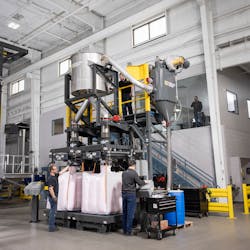Engineer-to-application: Bringing clarity and performance to process equipment project delivery
Efficient, effective project execution is important for successful project delivery of bulk material handling equipment, systems or projects. It is critical for all parties involved to have a clear understanding of the steps and timing required to successfully deliver a project from inception through commissioning.
Project owners, architecture, engineering and construction firms (AECs) and engineering, procurement and construction firms (EPCs) working on processing projects need clarity and confidence when specifying and integrating bulk material handling equipment into processing environments. The engineer-to-application (ETA) project delivery method developed by National Bulk Equipment (NBE) aligns processing equipment manufacturing with project execution methods and insights already recognized and practiced by project owners, AECs and EPCs. ETA project delivery enables these project stakeholders to move beyond the limitations of build-to-order or engineer-to-order project delivery experiences and proceed with the assurances of mutually defined expectations and tangible objectives.
ETA project delivery is conducted through an open and deliberate implementation of three performance categories:
- Collaborative project execution
- Tangible expertise and insights
- Full-stream capabilities and performance
Each performance category is essential; no two categories can fully contribute to ETA without the third. Also, each performance category contains specific project advantages, with each project advantage offering project benefits and each project benefit leveraged as necessary for project performance.
Collaborative project execution
Many bulk material handling equipment buyers have experienced the frustrations associated with purchasing build-to-order or engineer-to-order equipment, with their application needs not being accurately addressed or their process not properly understood.
The ETA project delivery method allows for collaboration between project managers and teams from other practice areas to create a more accurate and effective solution to meet project requirements and help keep the project on scope, on schedule and on budget.
Proactive project analysis and reporting to identify and mitigate risks
A proactive application analysis is performed to provide clarity around project application requirements and opportunities. The application analysis can include pre-RFQ on-site evaluations to identify strategic considerations and pre-RFQ feasibility testing to confirm those strategic considerations. This analysis and testing enable the customer to make informed decisions faster.
Furthermore, risk assessment reporting helps to identify risks and provide mitigation options by incorporating equipment into site safety management plans. Process flow diagrams and 3D modeling are also created to help ensure that performance requirements are met across the project from pre-RFQ feasibility testing through installation, startup and turnover.
Installation, commissioning and training to save time and improve operator efficiency
Project installation and startup services provide expert support and onsite training to improve operator efficiency. NBE equipment and systems ship factory wired and plumbed to minimize installation costs and enable reliable commissioning and efficient startup.
Tangible expertise and insights
In today's uncertain market conditions, the strategic importance of agility for processing operations has increased, creating new challenges for equipment design and engineering.
The tangible expertise and insights that come from developing bulk material handling systems for specific applications across diverse industries are critical to the ETA method. At NBE, every practice area, from applications engineering, mechanical engineering and automation engineering to project management, fabrication and assembly, and customer service is an essential contributor to the knowledge base of processing applications.
Process material analysis and testing to help eliminate delay and accelerate factory acceptance
Analyzing and testing the process material is critical to evaluate the effects of material characteristics from the full-stream context of a project. Determining how a specific material performs under particular conditions helps applications engineering and process engineering to eliminate delays and accelerate factory acceptance, even across a variety of regulatory standards and guidelines.
Application-specific regulatory guidance
Application-specific regulatory guidance helps ensure compliance with critical codes and standards across projects.
Classification compliance
Systems must be designed and constructed to meet all applicable UL standards including UL 508A, Class I and II, Division 1 and 2, Group A–D, F and G, as well as enclosures with Type X or Z purge.
Process guidance for controls automation and integration
Controls automation and integration range from ensuring intuitive, standardized HMI screen layouts across the project to project-wide fault management and recovery protocols to providing comprehensive data gathering and reporting.
While a customer’s engineers and operators are often familiar with the implementation of an automation environment, there may be other customer-side participants who are not comfortable with the complexities and vocabulary of process automation. NBE automation engineering brings process guidance to customer operations, from project-wide performance reporting and management information resources to smart-machine safety and maintenance conditions monitoring, including proactive risk mitigation strategies for dust control.
Full-stream capabilities and performance
A project may be required to be managed with full-stream capabilities, from upstream raw material discharge and storage to midstream raw material conveying and transformation to downstream, finished product packaging and reclamation. The ETA project delivery method offers an effective approach to ensuring that a project’s upstream, midstream, and downstream performance objectives are achieved.
Facilities enable equipment assembly, testing and analysis and automation advancements
The equipment supplier must have adequate facilities to foster, develop and build effective project designs. They should also be capable of providing design feasibility testing, material characteristics analysis, equipment automation advancements, and full-scale FATs.
Vertically integrating engineering with fabrication and assembly enables accurate, reliable and repeatable equipment performance. ETA project delivery provides a single point of accountability for all aspects of a project, from design through commissioning and installation, eliminating many of the challenges associated with traditional methods.
Global perspective and proficiency increase total process contribution
Bulk material handling equipment is designed to comply with international standards, reducing maintenance and training costs and increasing total process contribution.
Upstream, midstream, and downstream equipment and systems contribute to process effectiveness and TCO
With ETA, equipment and systems are built to contribute to process effectiveness and provide total cost-of-ownership advantages across the full stream of production operations, from upstream raw material discharge and storage through midstream material conveying and transformation to downstream processing and reclamation.
Each project is designed, engineered, and constructed based on application-specific insights and expertise brought by collaboration between the supplier, project owner, AEC and EPC.
Full-stream projects, systems and equipment integration advance performance objectives of upstream, midstream and downstream applications
The same engineer-to-application performance categories of full-stream project delivery are applied to equipment or systems to advance the performance objectives of upstream, midstream, and downstream applications. Such full-stream offerings provide total cost-of-ownership advantages to project owners.
Conclusion
With ETA project delivery, bulk material handling equipment, systems and projects are designed, engineered, manufactured, installed and commissioned to support customers in solving their business and operational challenges. By listening to customers, understanding their challenges and the outcomes they are looking for, collaborating with them to design the right solutions, and applying those solutions, ETA can help projects reach their full potential while reducing total-cost-of-ownership.
Chuck Johnson is the director of sales at National Bulk Equipment, located in Holland, Michigan. His professional experience includes over 25 years in the design, engineering, and sales of bulk material handling equipment and systems. Johnson holds a BS in mechanical engineering from Michigan State University.
National Bulk Equipment
About the Author

Chuck Johnson
Director of sales at National Bulk Equipment
Chuck Johnson is the director of sales at National Bulk Equipment, located in Holland, Michigan. His professional experience includes over 25 years in the design, engineering, and sales of bulk material handling equipment and systems. Johnson holds a BS in mechanical engineering from Michigan State University.

